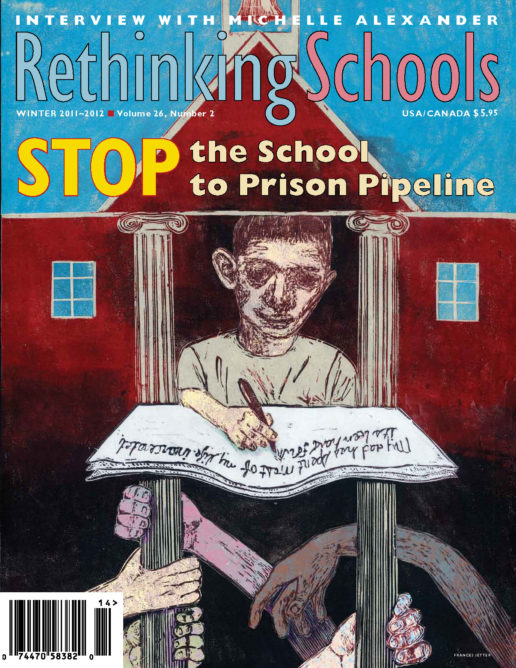Preview of Article:
The Classroom to Prison Pipeline
Illustrator: Meredith Stern
The school-to-prison pipeline starts in the classroom. I know. During 4th-period English, I came dangerously close to becoming the teacher who pushes students out of class into the halls, into the arms of the school dean, and out into the streets. I understand the thin line teachers tread between creating safe classrooms and creating push-out zones.
It started harmlessly enough. This September I returned as a volunteer to the school where I taught for more than two decades to co-teach junior English with a fabulous teacher, Dianne Leahy. Forty students are stuffed into our classroom. The school district instituted another new schedule to save money, so we only see our students every other day for 90 minutes. A few weeks into the school year, and I was still confusing Ana and Maria, Deven and Terrell, and Melissa and Erika. Daily it took so long to settle the students down that Dianne and I were exasperated by how little real work students completed. We battled competition with cell phones and side talking, as well as frequent interruptions due to students strolling into and out of the classroom or plugging in their cell phones or iPods while we attempted to demonstrate a writing strategy. In addition to the lack of forward movement on reading and writing during the day, students did not complete their homework. Embarrassed by their behavior and their skimpy work, I hoped that no one would walk in and see us totally at the mercy of these 16- and 17-year-olds.
We tried to build relationships. Dianne found out what sports kids played, who danced, who was a cheerleader, who loved skateboarding. I watched her kneel in front of kids as she passed out folders with a word of praise or a question that demonstrated she cared about them as individuals. Because I was out of the class during the opening days of the year, I followed her lead, attempting to connect names to faces and faces to aspirations.
While out on a hike after a particularly frustrating day, I remembered a former student, Sekou, who returned from Morehouse College with a story about a ritual that he participated in during the early days of his freshman year. I thought Dianne and I needed a ritual to help students remember that the classroom is a sacred place of learning. Eager to create community out of the chaos, I prepared a document for students to sign that promised they would complete their work, refrain from using cell phones, and participate fully in class by respectfully listening to others. Now, even as I write this list, it doesn’t sound too farfetched. In fact, it sounds like what school is about. My huge mistake was asking them to sign the paper—and to participate in a ritual where we walked back into the classroom saying, “I am a scholar.” Who did I think I was—Michelle Pfeiffer from Dangerous Minds?

